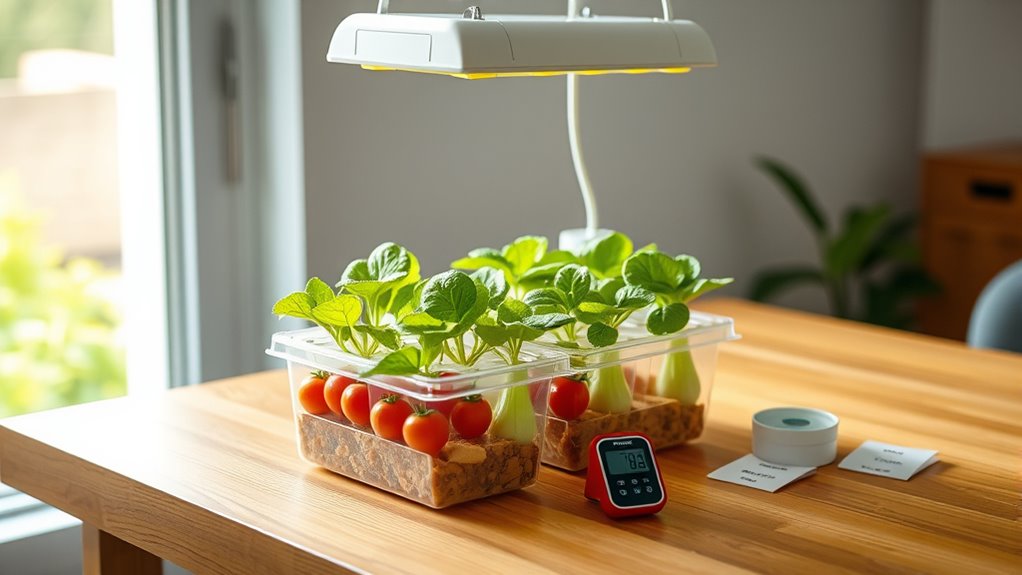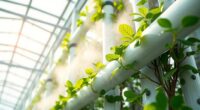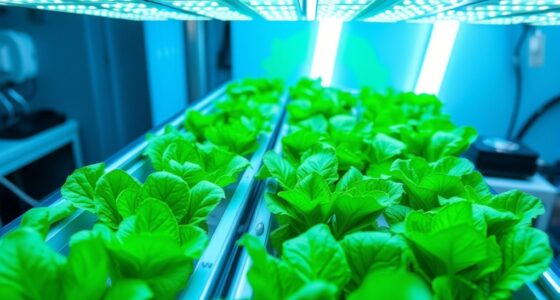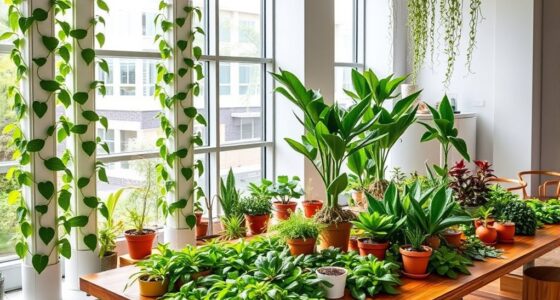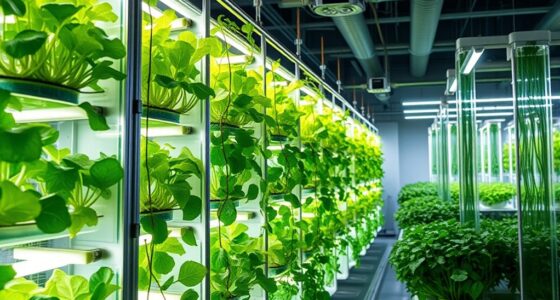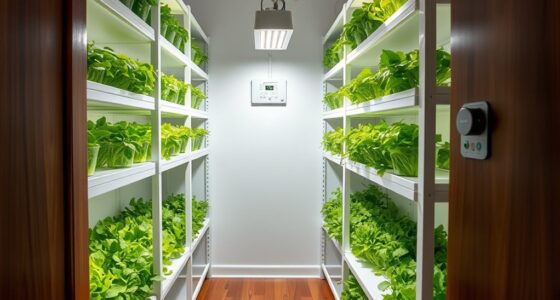To pick the perfect beginner hydroponic kit, assess your available space, lighting, and budget first. Choose a system type like NFT, DWC, or drip based on your needs and room size. Opt for kits that include essential components like grow lights, pH testers, and quality containers. Select easy-to-grow plants like lettuce or herbs for quick success. Focusing on these factors will help you start strong; explore more tips as you get started.
Key Takeaways
- Choose a system type (NFT, DWC, drip, wick) based on your space, lighting, and plant needs.
- Prioritize kits with quality components like grow lights, containers, pH testers, and reliable pumps.
- Select easy-to-grow, fast-maturing plants such as lettuce, basil, or spinach for quick results.
- Ensure the kit includes essential nutrients and tools for regular maintenance and pH regulation.
- Assess your budget and space to find a beginner-friendly, durable setup that suits your growth goals.
Understanding Different Types of Hydroponic Systems

To effectively choose a hydroponic system, it’s important to understand the main types available. Each system varies in how it delivers nutrient solutions to your plants and how you manage pH regulation. Nutrient film technique (NFT) systems circulate a thin layer of nutrient-rich water over plant roots, requiring careful pH adjustments to prevent nutrient lockout. Deep water culture (DWC) systems submerge roots in nutrient solutions, making pH regulation vital for plant health. Drip systems deliver nutrients directly to each plant, allowing precise control over nutrient levels and pH. Wick systems use capillary action to draw nutrients to the roots, generally needing less pH management. Knowing how each type manages nutrient solutions and pH helps you pick the best system for your space and experience level. Additionally, understanding the nutrient delivery methods can help optimize plant growth and prevent deficiencies.
Assessing Your Space and Lighting Conditions
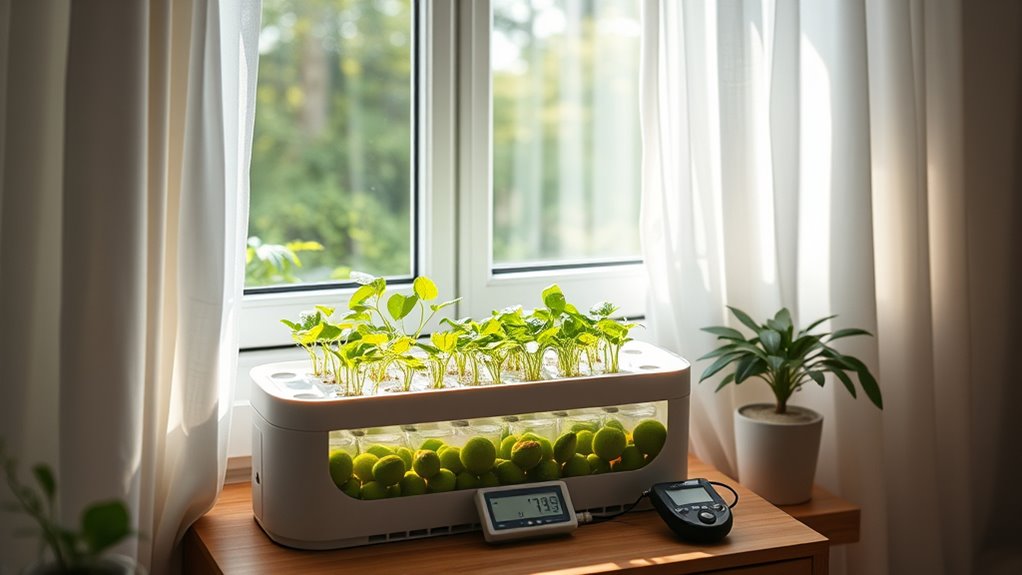
To choose the right hydroponic kit, you need to consider your available space and how much light your environment provides. Take a close look at where you’ll set up your system and note if it gets enough natural light or if you’ll need supplemental lighting. Knowing these details helps ensure your plants thrive from the start. Additionally, understanding the low light conditions of your environment can help you select plants and equipment that will perform well without extensive modifications.
Available Space Considerations
Before setting up a hydroponic kit, evaluating your available space and lighting conditions is essential. You need to plan for effective space optimization to guarantee your setup fits comfortably without overcrowding. Measure the area carefully, considering room for growth and future expansion. Think about storage solutions for supplies, tools, and maintenance items; organized storage keeps your setup efficient and accessible. If your space is limited, opt for compact or vertical hydroponic systems that maximize vertical space. Avoid clutter that could hinder airflow or access. Remember, a well-organized, appropriately sized area not only makes maintenance easier but also promotes healthy plant growth. Taking these steps now saves you time and effort later, helping you choose a beginner setup tailored perfectly to your space. Additionally, understanding lighting conditions ensures your plants receive the right amount of light for optimal growth.
Lighting Environment Assessment
Evaluating your space for a hydroponic setup includes assessing the lighting conditions, since light considerably impacts plant growth. Start by checking the light intensity in your area; most plants need at least 12-16 hours of adequate light daily. If natural light is limited, consider supplementing with grow lights to ensure proper light exposure. Also, determine the light duration your plants will receive, as consistent light cycles promote healthy growth. Observe how much sunlight your space gets naturally and note any shade or obstruction that could reduce light levels. Adjusting light intensity and duration guarantees your plants get the ideal environment to thrive. Proper evaluation helps you choose the right lighting setup, making your hydroponic system more successful from the start.
Setting a Realistic Budget for Your Starter Kit
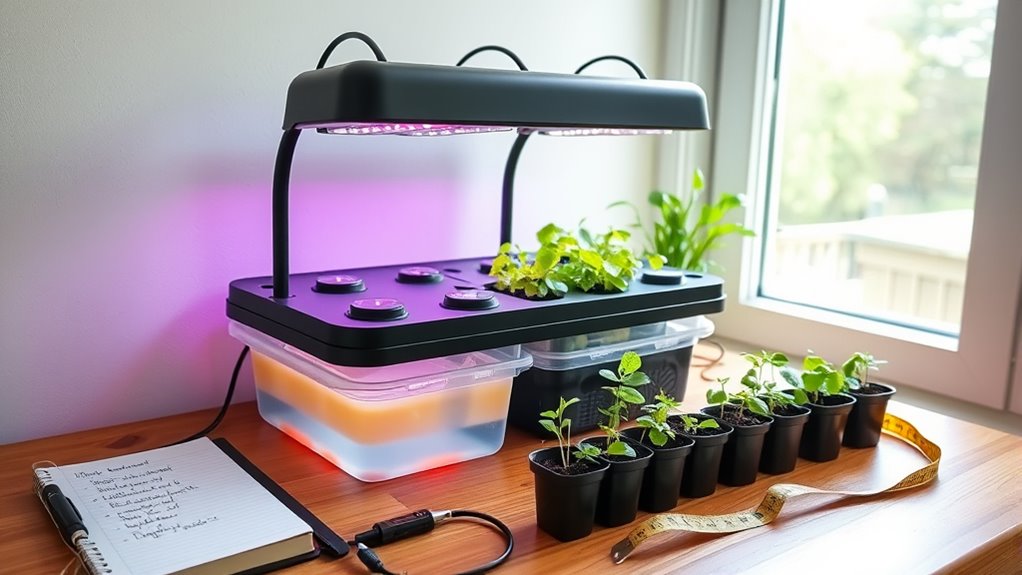
Setting a realistic budget is essential to guarantee you invest wisely in your starter hydroponic kit without overspending. Start with a clear cost estimation by listing essential components like the grow container, lighting, nutrient solutions, and pumps. Research prices to understand what fits your financial situation, and don’t forget to include ongoing costs such as replacement parts or electricity. Effective budget planning helps you prioritize features that matter most for beginners, ensuring you avoid unnecessary expenses. Remember, a higher price doesn’t always guarantee better results; focus on quality within your budget. By carefully evaluating costs upfront, you’ll set a solid foundation for a successful hydroponic setup that’s both affordable and effective. Additionally, exploring for sale options can help you find quality equipment at competitive prices.
Choosing the Right Plants for Beginners
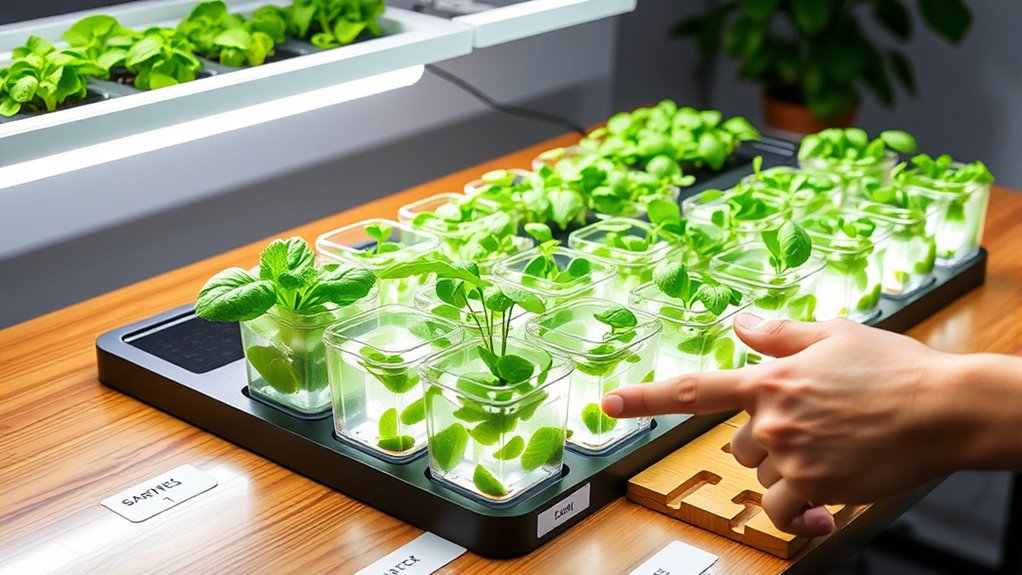
When starting with hydroponic kits, choosing plants that are easy to grow makes the process smoother. Look for fast-growing varieties that give you quick results and keep you motivated. Low-maintenance plants are ideal for beginners, so you can enjoy gardening without too much effort.
Easy-to-Grow Options
If you’re just starting with hydroponics, choosing easy-to-grow plants can make the process more enjoyable and successful. Leafy greens like lettuce, spinach, and arugula are ideal because they thrive in hydroponic systems. These plants require straightforward nutrient solutions and are forgiving if pH monitoring isn’t perfect at first. Their quick growth cycles mean you’ll see results fast, boosting your confidence. Herbs such as basil, mint, and cilantro also grow easily and add flavor to your meals. Focus on maintaining a stable pH level, usually between 5.5 and 6.5, to keep your plants healthy. Starting with these simple options reduces frustration and helps you learn the basics of nutrient management, making your hydroponic journey smoother and more rewarding. Additionally, understanding organic and natural nutrients can further enhance your plant growth and health.
Fast-Growing Varieties
Choosing fast-growing varieties can give you quick results and boost your confidence in hydroponics. When selecting plants, focus on seed selection and their nutrient requirements to guarantee success. Fast growers like lettuce, spinach, basil, and radishes are ideal for beginners. Consider these factors:
- Seed selection: Pick resilient, beginner-friendly seeds that sprout quickly.
- Growth rate: Opt for plants with short maturation times.
- Nutrient needs: Choose varieties with moderate nutrient requirements that your kit can easily supply.
- Space efficiency: Select plants that grow well in limited spaces, maximizing your setup.
Additionally, choosing plants with moderate nutrient requirements ensures your hydroponic system can maintain healthy growth without overloading your setup.
These choices help you maintain an easy, rewarding hydroponic experience while learning the basics of plant growth.
Low Maintenance Plants
Starting with low maintenance plants makes your hydroponic journey easier and more enjoyable. These plants require minimal plant selection effort and infrequent watering, reducing stress and frustration. Choose varieties like lettuce, basil, spinach, mint, or kale—they thrive in beginner setups. Their forgiving nature means you won’t have to worry about overwatering or neglecting them. For ideal growth, adjust watering frequency based on plant needs, ensuring roots stay moist but not waterlogged.
| Easy-to-Grow Plants | Watering Frequency |
|---|---|
| Lettuce | Every 2-3 days |
| Basil | Every 3-4 days |
| Spinach | Every 2-3 days |
| Mint | Every 4-5 days |
| Kale | Every 3-4 days |
Choosing these plants simplifies your hydroponic experience and boosts confidence.
Evaluating Kit Features and Included Components
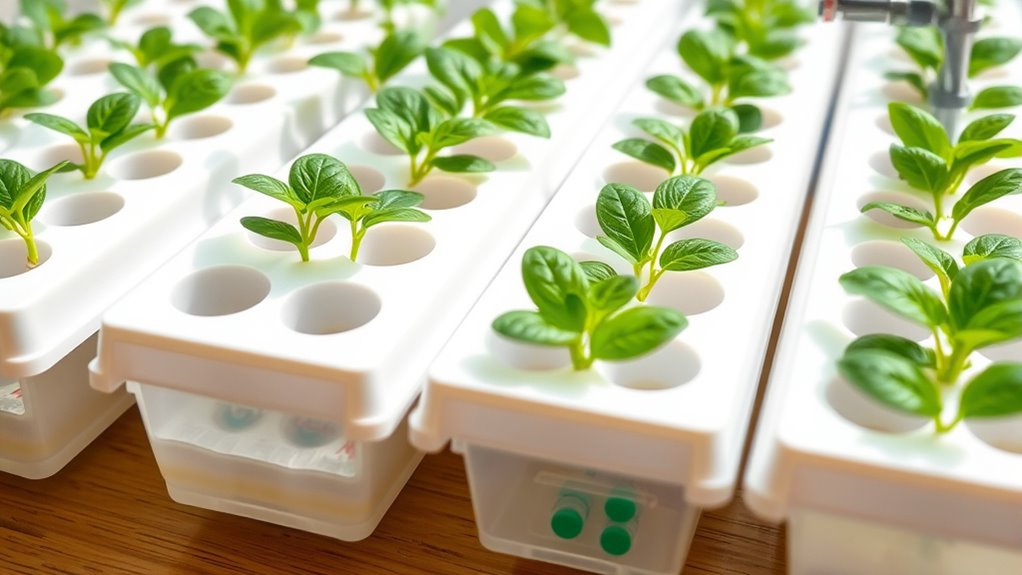
When evaluating starter hydroponic kits, it’s essential to carefully consider the features they offer and the components included. First, check if the kit provides nutrient solutions tailored for easy plant growth, ensuring your plants get vital nutrients. Second, verify if grow lights are included, as proper lighting accelerates healthy development. Third, examine the quality of the containers and whether they’re designed for easy access and cleaning. Fourth, look for added components like pH testers or air pumps, which support ideal root health. These features directly impact your success and ease of use. Additionally, understanding the importance of quality assessment can help you select a kit that offers durable and reliable components. By understanding what’s included, you can choose a kit that simplifies setup, maintains plant health, and provides everything needed for a thriving hydroponic garden.
Tips for Easy Maintenance and Successful Growing

Maintaining your hydroponic system is key to ensuring healthy plant growth and a successful harvest. Regularly check your nutrient solutions, making sure they’re properly balanced and refreshed according to your plants’ needs. Keeping the nutrient levels consistent prevents deficiencies and promotes strong growth. Additionally, practice good pest management by inspecting plants frequently for pests or disease signs. Clean your system regularly to prevent algae buildup and blockages, which can hinder nutrient flow. Use gentle, plant-safe solutions if pests appear. Consistent monitoring, timely nutrient adjustments, and cleanliness create an ideal environment for your plants. Proper food safety practices, such as using clean tools and avoiding contamination, help maintain a healthy growing environment. With these simple steps, you’ll enjoy a thriving hydroponic garden and a bountiful harvest, even as a beginner.
Frequently Asked Questions
How Long Does It Take to See Results With a Starter Hydroponic Kit?
When you start with a hydroponic kit, you’ll see initial results within a week or two, depending on the plants. Your growth timeline varies based on factors like light, nutrients, and plant type. Typically, you’ll notice sprouting or small leaves early on. Keep in mind, steady care and proper setup speed up your journey to healthy, thriving plants, making the wait worthwhile.
Can I Grow Herbs and Vegetables Together in One System?
You can mix herbs and vegetables in one system, but it’s a delicate dance. Think of it as companion planting—some plants thrive together, sharing nutrients and space, while others compete. Check crop compatibility to avoid issues like overgrowth or pests. By selecting compatible herbs and veggies, you’ll create a balanced environment, ensuring all your plants flourish. Just keep an eye on their needs, and you’ll have a thriving, diverse hydroponic garden.
What Are Common Troubleshooting Issues for Beginner Hydroponic Setups?
When troubleshooting your beginner hydroponic setup, you might face pH imbalances and algae growth. You should regularly check and adjust the pH levels to keep your plants healthy. To prevent algae, make certain your system is covered or use algae-resistant solutions. Also, keep your water clean and maintain proper nutrient levels. These steps help you avoid common issues and keep your hydroponic garden thriving.
Do Starter Kits Require Any Special Water or Nutrient Treatments?
Think of your hydroponic setup as a delicate dance, and water quality is the music that keeps everyone in sync. Starter kits usually don’t require special water treatments, but you should check your water’s pH and adjust if necessary. To guarantee healthy growth, maintain a proper nutrient balance and use the recommended liquid nutrients. This way, your plants thrive without extra fuss, like a well-rehearsed performance.
How Often Should I Replace or Upgrade Components in My Kit?
You should regularly check your hydroponic system for component maintenance, such as pumps, lights, and tubing, to make sure everything runs smoothly. Replace parts as needed—generally every 6-12 months—based on wear and performance. System upgrades can improve yields or efficiency, so consider updating your setup when you notice declining plant health or outdated technology. Staying proactive helps keep your hydroponic garden thriving and productive.
Conclusion
Now that you’ve got a grasp on selecting the perfect starter hydroponic kit, you’ll be well-equipped to grow fresh herbs and veggies with ease. Remember to contemplate your space, budget, and plant choices carefully, and don’t be afraid to start simple—think of it as your own Renaissance of homegrown goodness. With patience and attention, you’ll enjoy bountiful harvests and the satisfaction of cultivating your own verdant paradise—an endeavor worthy of the greatest botanists of old.
